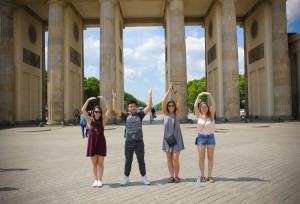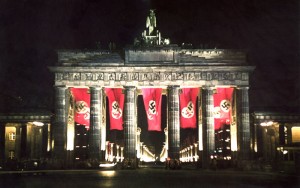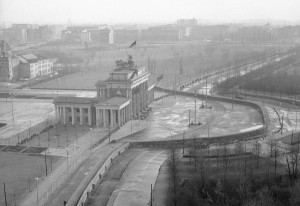When people think of Berlin, a few images come to mind. They think of the wall and all of its murals, of a thriving city covered with bustling people, but more often than not, they think of the Brandenburg Gate. Before leaving for Berlin, everyone I knew told me that I absolutely had to see it. I understood that it was a big site in Berlin, that it had a lot of history and a beautiful appearance, but I really didn’t understand its importance.
To get some background knowledge on the Gate, I decided to do a little digging before my departure. When I Googled it, I was amazed at the results. Thousands of images covered the page, each of them demonstrating a critical time in German and world history with the Gate tucked neatly in the back. From Nazis marching in front of it to Germans celebrating the fall of the wall behind it, I was amazed to see that the Gate had witnessed so much of history. A lot of the photos were familiar, such as the one below from MSNBC. These were photos that I had seen in our American media and had never realized that the Gate was in every one.
Now that I understood just how prominent the Gate was, I was really excited to see it in person. It was like meeting a celebrity: something you had seen on TV and the media but now get to see in person. When we finally came across it, it was more incredible than I could have imagined. The sheer mass and size of this structure was jaw-dropping. The detail in each column and the statue at the top was magnificent. I’m not usually interested in buildings and architecture, but the Brandenburg Gate left me speechless.
I was happy to have the opportunity to do further research on the Gate when picking a topic for the blog. Learning the history of the Gate makes seeing it even more incredible. Throughout its history, the overarching theme was clear: the Gate was everyone’s perfect propaganda. The Gate was a symbol of Berlin. When Napoleon stole the statue, he was declaring his ownership of the city. When Nazis marched through the Gate, they were demonstrating their control. And when people stood in front of the Gate to celebrate the end of the wall, it represented a new time for Berlin. Now, seeing it for myself, it’s clear to me why everyone makes such a big deal over a simple Gate. Because this is more than just a Gate, this is Berlin.
-Ellie
***
It was one of the first nights in Berlin when the iconic Brandenburg Gate gleamed through the dark streets as we quickly drove past it. I’ve heard about the Gate in the past as well as seen plenty of pictures but nothing could compare to its majestic reality.
Without knowing the history or past of this marvelous landmark, we searched for this Gate a few days after. Walking up to the Gate gives one a feeling of honor and regality despite anyone’s individual experiences. As I stood with the other students, feeling dwarfed in the Gate’s presence, we observed its features in detail. I noticed the Quadriga on the top of the Gate and was curious as to why it had Greek influence. This is what really struck my interest in learning about the history of this landmark and why it attracts so many people.
The significance of the Brandenburg Gate changed throughout history but its original purpose was to be a grand entrance for royals entering the city. The middle gate was used only for royals while the others for common traffic. It’s interesting now to see it solely as an attraction because the street through it no longer exists. As you walk up to the Gate and pass through, one feels the sense of royalty it was intended to provide. The rich history of the Gate varied with the challenges of Germany and Berlin during wars, the Berlin Wall and many other hardships, creating individual meanings for each person who visits it. This special characteristic has a lasting impact on visitors that observe its beauty, which is the main reason I find this Gate so intriguing to learn about.
Today, the Gate is a gathering place for speeches, celebrations, or any other event where people want to make an impression on the city or the population. It’s presence is truly an honor for the people of Germany and others from all over the world.
The Brandenburg Gate, as mentioned before, has changed significance many times throughout history. Originally it was built as a grand entrance to the city. Many years after, the Berlin wall was constructed and the landmark was trapped in the East and no longer attracted people; however, famous speeches such as those by President Ronald Reagan and John F. Kennedy were delivered here, providing hope for a reunited Germany. Other prevalent events of the past took place here including a celebration for Adolf Hitler after he was appointed chancellor and, later, for his birthday. After the wall came down the Gate then became a symbol of unity while also maintaining its previous significance –victory.
From the beginning this structure was famous. With its intricate and delicate architecture as well as brilliant design and location, the Gate is hard to miss. While it’s symbolism has changed over time, it’s reputation and popularity only continued to grow.
-Kelly





